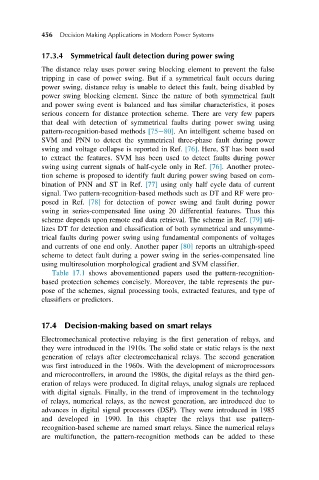Page 496 - Decision Making Applications in Modern Power Systems
P. 496
456 Decision Making Applications in Modern Power Systems
17.3.4 Symmetrical fault detection during power swing
The distance relay uses power swing blocking element to prevent the false
tripping in case of power swing. But if a symmetrical fault occurs during
power swing, distance relay is unable to detect this fault, being disabled by
power swing blocking element. Since the nature of both symmetrical fault
and power swing event is balanced and has similar characteristics, it poses
serious concern for distance protection scheme. There are very few papers
that deal with detection of symmetrical faults during power swing using
pattern-recognition-based methods [75 80]. An intelligent scheme based on
SVM and PNN to detect the symmetrical three-phase fault during power
swing and voltage collapse is reported in Ref. [76]. Here, ST has been used
to extract the features. SVM has been used to detect faults during power
swing using current signals of half-cycle only in Ref. [76]. Another protec-
tion scheme is proposed to identify fault during power swing based on com-
bination of PNN and ST in Ref. [77] using only half cycle data of current
signal. Two pattern-recognition-based methods such as DT and RF were pro-
posed in Ref. [78] for detection of power swing and fault during power
swing in series-compensated line using 20 differential features. Thus this
scheme depends upon remote end data retrieval. The scheme in Ref. [79] uti-
lizes DT for detection and classification of both symmetrical and unsymme-
trical faults during power swing using fundamental components of voltages
and currents of one end only. Another paper [80] reports an ultrahigh-speed
scheme to detect fault during a power swing in the series-compensated line
using multiresolution morphological gradient and SVM classifier.
Table 17.1 shows abovementioned papers used the pattern-recognition-
based protection schemes concisely. Moreover, the table represents the pur-
pose of the schemes, signal processing tools, extracted features, and type of
classifiers or predictors.
17.4 Decision-making based on smart relays
Electromechanical protective relaying is the first generation of relays, and
they were introduced in the 1910s. The solid state or static relays is the next
generation of relays after electromechanical relays. The second generation
was first introduced in the 1960s. With the development of microprocessors
and microcontrollers, in around the 1980s, the digital relays as the third gen-
eration of relays were produced. In digital relays, analog signals are replaced
with digital signals. Finally, in the trend of improvement in the technology
of relays, numerical relays, as the newest generation, are introduced due to
advances in digital signal processors (DSP). They were introduced in 1985
and developed in 1990. In this chapter the relays that use pattern-
recognition-based scheme are named smart relays. Since the numerical relays
are multifunction, the pattern-recognition methods can be added to these

